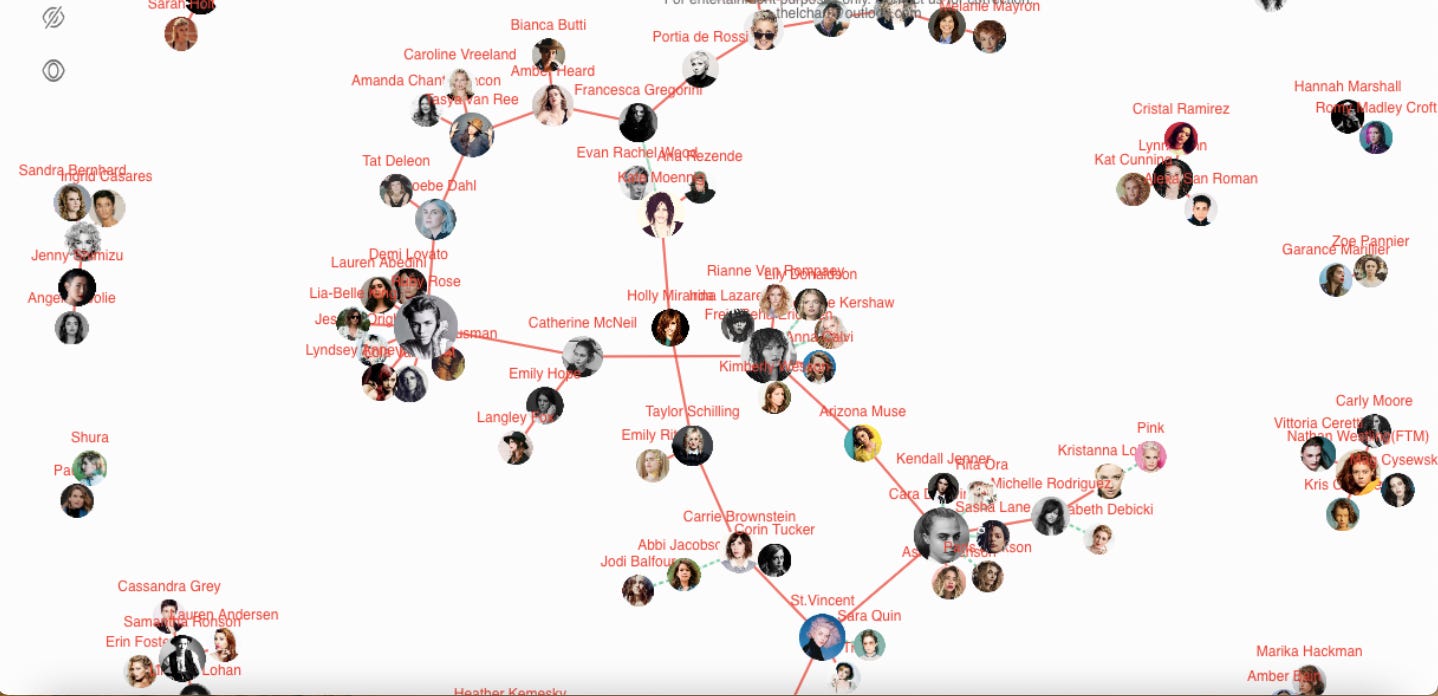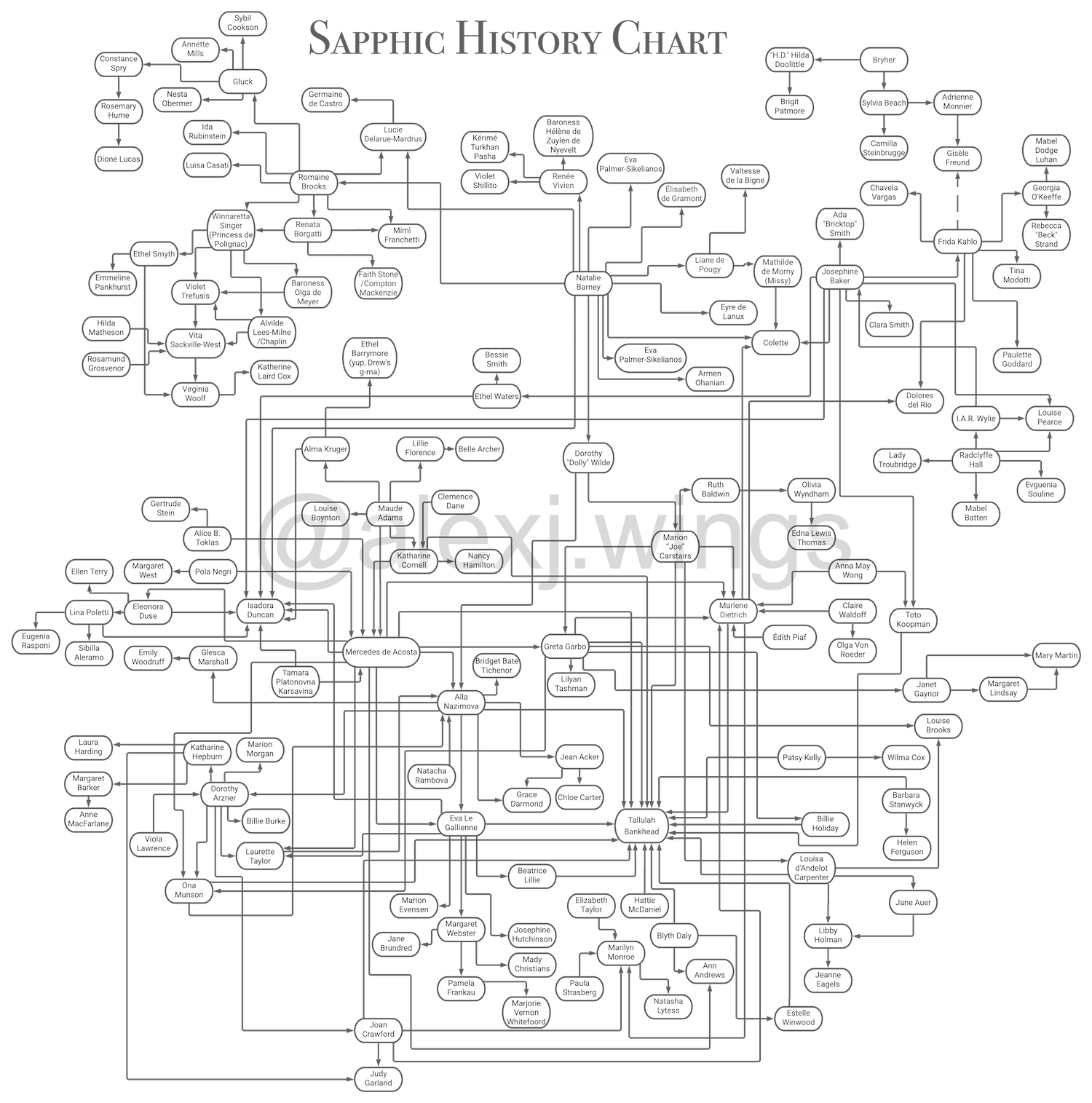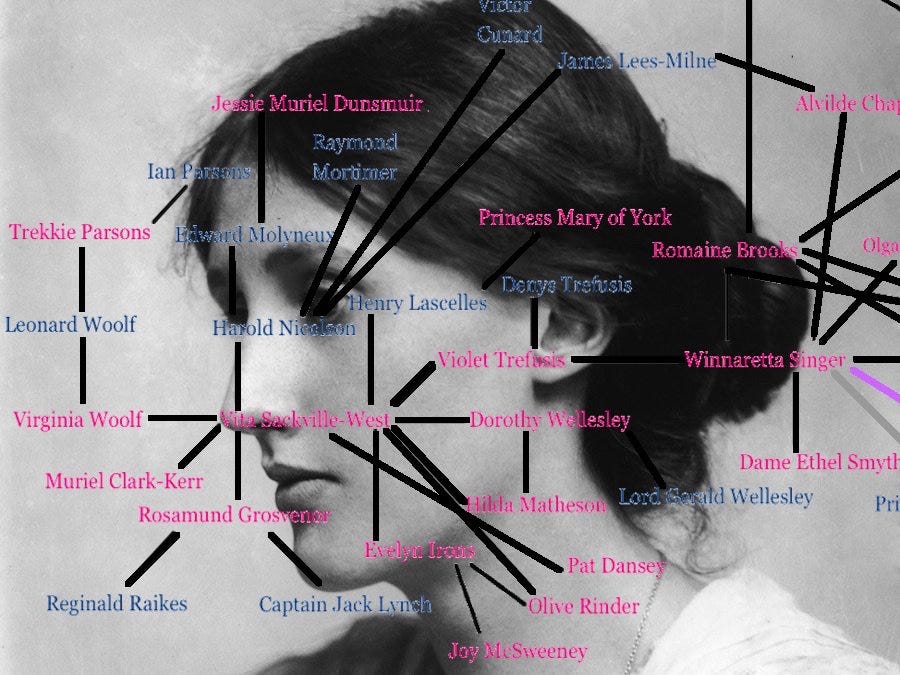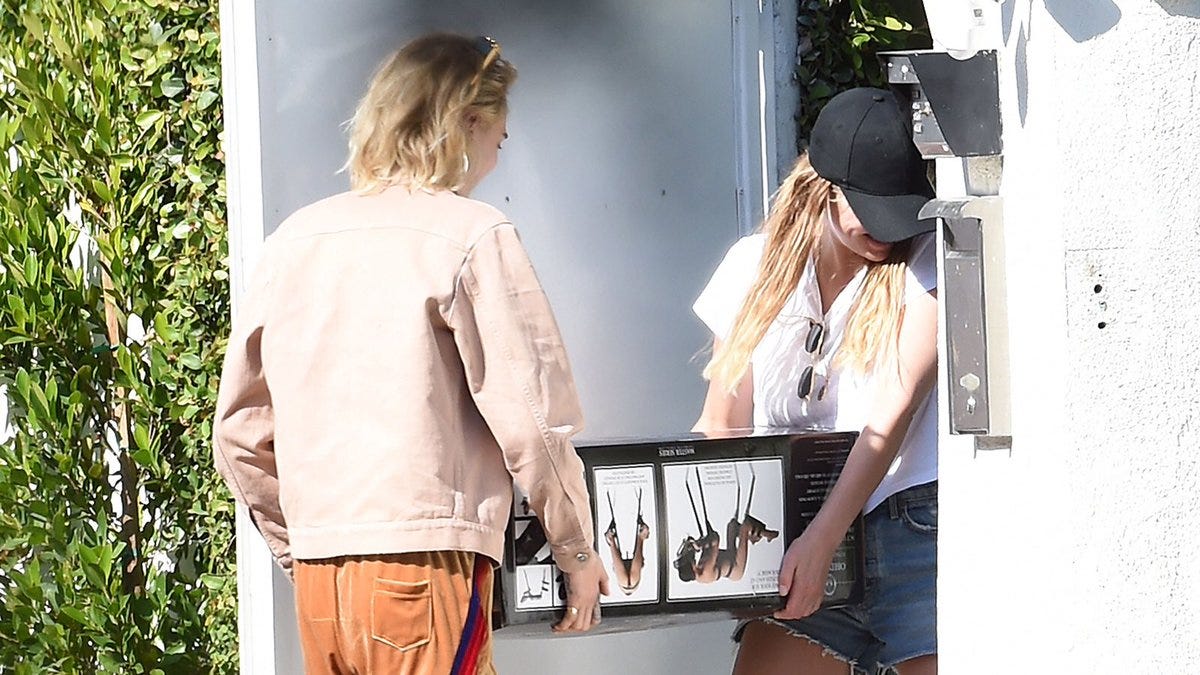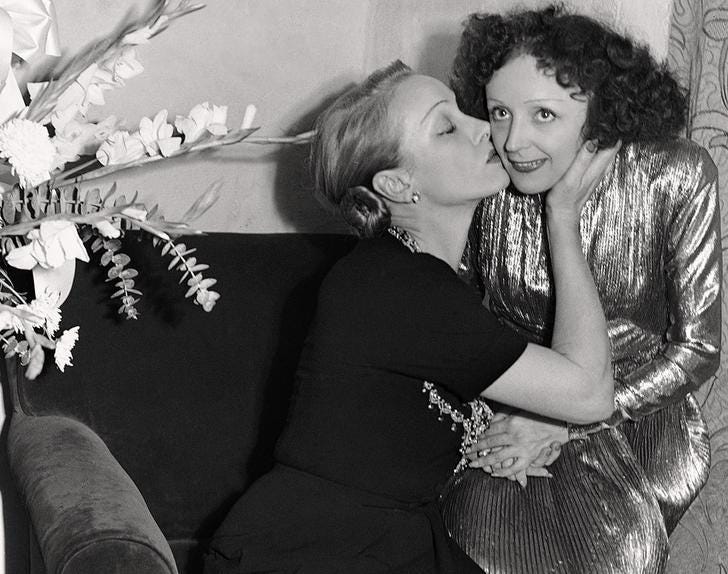Paging Dr. Lesbian - The L Chart and the Living Archive
This is the Sunday Edition of Paging Dr. Lesbian. If you like this type of thing, subscribe, and share it with your friends. A paid subscription gets you more writing from me and will help me keep this newsletter afloat. Consider going paid! Upgrading your subscription will get you access to things like my review of the lesbian fashion at the Oscars or musings about how the Arthur reboot is gay. The year is 2004, the month is January. The city is Los Angeles (but actually it’s Vancouver). It’s the second part of the two-part pilot of The L Word, and Alice Pieszecki has just invented The Chart. For those unfamiliar, The Chart is an extensive diagram that lays out all the (fictional) lesbians and bisexuals of Los Angeles, indicating how they are all connected to one another through various relationships or hookups. The ever-curious Alice created the chart in order to show how insular the lesbian community of L.A. is, and, while it’s initially drawn out on a whiteboard, her goal is to put it online. (As Maddy Court asks in her newsletter, did Alice invent social media?) As Alice describes it, “the point is we're all connected, see? Through love, through loneliness, through one tiny, lamentable lapse in judgment. All of us, in our isolation, we reach out from the darkness, from the alienation of modern life, to form these connections. I think it's a really profound statement about the nature of human existence.” Sure, Alice was definitely an asshole who loved invading people’s privacy, but her point is compelling. There’s a whole subplot where Alice pitches the idea of the chart to her editor and he doesn’t go for it so she writes an article about “vaginal rejuvenation” instead, but we don’t need to get into that right now. The point is, even though it never became a huge part of the diegetic world of the show itself, The Chart has become one of the most enduring legacies of the series and continues to spawn memes and references to this day. Much has been said about the aspects of the show that have not aged well, but the cultural lexicon it spawned – exemplified most clearly by The Chart – is undeniable. Clearly, the idea of The Chart was a popular one (though Ilene Chaiken and co. were certainly not the first ones to imagine the lesbian community in this way), as it actually spawned a social media site and blog called OurChart.com in 2006. The site included articles, forums, and also allowed users to create profiles and add themselves to a living, breathing chart like the one Alice created. (The site is no longer up, but you can visit it through the Way Back Machine.)¹ Alice’s chart has been reproduced many times, most recently (and perhaps most famously) with an anonymous site called The L Chart. The site is an interactive diagram that tracks celesbians and their various romantic exploits, connecting them to one another in a complex web. (Red lines indicate a confirmed relationship, green lines indicate a rumored relationship.) Unsurprisingly, Kristen Stewart features quite prominently on the chart, indicating to some that she is the “Shane” of contemporary celesbians. (Shane was the lothario of The L Word and also had many connections on Alice’s chart.) The site is uncredited and the creator(s) behind it are not publicly known, but it is updated semi-regularly and there is an attached email address where you can send corrections. As of this writing, there are 141 nodes on the chart, and many of them are connected to one another. For example, Miley Cyrus is connected to The L Word’s Kate Moennig (AKA Shane) through Stella Maxwell, Kristen Stewart, St. Vincent, Carrie Brownstein, Taylor Schilling, and Holly Miranda. (They’re also connected in an even more circuitous route that I won’t list here.) Others, who have only dated one or two people, are on the chart but not connected to a larger web. For example, Sarah Paulson is only connected to Cherry Jones and Holland Taylor and no one else. It’s a fascinating project, one made all the more interesting by the fact that it’s a living, breathing archive. While such a concept may seem especially modern (or at least post-internet), it’s actually been applied to other moments in history, as well. After reading about writer and socialite Natalie Clifford Barney² and her polyamorous partner of more than 50 years, the painter Romaine Brooks, a 20-something lesbian named Alex J. Mack decided it would be a fun project to try and connect all of these early 20th-century sapphics to one another. Clifford Barney, an American ex-pat living in Paris starting in the 1910s, had an astounding group of lovers and friends in her circle, including French writer Colette and famous courtesan Liane de Pougy.
The sapphic scene in Los Angeles was just as bustling, with everyone from Marlene Dietrich, Greta Garbo, and Barbara Stanwyck dabbling in what was then known as “The Sewing Circle.” (The Sewing Circle is a term used to describe the women in Hollywood from the 1920s to the 1940s who loved other women – there were a lot of them!) Actress Tallulah Bankhead, who was most famously linked to Billie Holiday, features most centrally in this chart, leading some people to describe her as the Shane of classical Hollywood. Getting even more micro with things, Cassie Sheets decided to see if a similar assembly could be done within the insular British literature community of Virginia Woolf and her cohort, and it turns out, it can. Sheets wanted to see if she could connect Woolf to Dame Ethel Smyth, a composer who was in love with Woolf for many years. Though Woolf only ever slept with two people that we’re aware of – her husband and Vita Sackville-West – Sheets was still able to connect Woolf to Smyth by only four degrees of separation. All of this is to say that dyke drama – in its many iterations – is timeless. There is a fascinating historical linkage here, especially when we think about how many similarities there are between lesbian culture now and lesbian culture 100 years ago. The drama was maybe even more fascinating back in the day because things were even more insular in the pre-internet days of Clifford Barney and Bankhead. For example, in her delightful book The Girls: Sappho Goes To Hollywood, Diana McLellan details the dramatic history of Greta Garbo and Marlene Dietrich. As the story goes, Garbo and Dietrich met in the 1920s in Berlin and had a brief affair that ended with Garbo feeling mortally wounded by Dietrich’s dismissal of her. Several years later they both wound up in L.A. where they made a pact to never speak of or to each other again, even prohibiting their friends from ever mentioning the name of the other. For decades after this, they denied ever having met even a single time. To add even more intrigue to an already stirring drama, they also had a lover in common – Mercedes De Acosta, who is as famous for her written works as she is for her many lesbian love affairs.
Across the pond in Europe, Mercedes De Acosta and lesbian lothario Natalie Clifford Barney also had a lover in common – Isadora Duncan, the famous American dancer. Clifford Barney hobnobbed with many of the most famous women of her time, including Colette, Edna St. Vincent Millay, and even Mata Hari. Her and Romaine Brooks were also known to go on double dates with Gertrude Stein and her partner, Alice B. Toklas, later in life. See what I mean? Today, of course, we have all the famous people linked to the likes of Kristen Stewart, Ruby Rose, and Cara Delevingne, and these relationships are much more public than they would have been 100 years ago. (Though, to be fair, neither Dietrich nor Clifford Barney ever cared much about hiding their predilection for women.) This is one of the main differences between how these charts function today and how they would have (or did) function in the past. The reason we are able to create charts like the contemporary celesbian one in real-time is because lesbian and queer celebs have become increasingly open with their affections for one another. Moments like the famous Cara Delevingne/Ashley Benson sex bench scandal of 2019, or the Delevingne/Michelle Rodriguez beach excursion of 2014, would have been unimaginable in earlier decades. At the same time, things in classical Hollywood were not as closed off as one might imagine. Classic Hollywood stars were a famously wild bunch, and the sapphics were no exception. The women-loving exploits of stars like Dietrich and Bankhead were an open secret, and anyone familiar with Hollywood at the time knew what was going on. Sure, Dietrich wasn’t going to kiss a woman on the red carpet (like Kristen Stewart did this year), but the lesbian scene at the time was popping. Lesbian bars were en vogue, and even actresses who generally dated men, such as Joan Crawford and Marilyn Monroe, were rumored to have dabbled in the lady pond from time to time. Unfortunately, this all changed in the 1950s with the rise of McCarthyism and the push to sanitize Hollywood’s indecent image. As McLellan writes in her book, gone were the days when the studio machine would throw money at publicity problems until they went away – they had other worries now. This meant that the lesbian heyday of the 1920s and 30s was decisively over, and the Sewing Circle could no longer flourish like it once did. The trajectory of progress is not always linear, as we have hopefully learned by now. The archive that charts like these present us with are fascinating, and undoubtedly a significant part of lesbian history. But what of the celesbian chart of today? Is it a brilliant and influential document, or an invasion of privacy? One could certainly argue that the latter is true, but the digital archive this presents us with is hard to deny. From a historical perspective, the fact that we have this information – about Dietrich and her cohort, as well as Clifford Barney and her exploits in Paris – is a miracle in and of itself. There is clearly a desire for this type of historical record, as evidenced by things like the Vita & Virginia Bot on Twitter, which posts excerpts from their many letters to one another on an hourly basis. Historical records like these make one think about all the lesbian archives we don’t have. What about all those women Sappho was always fawning over? Why don’t we know more about lesbian nuns? (Benedetta not included.) And what if The L Word gets taken off Hulu or Netflix again? What then? Perhaps we will have to rely on the people with L Word box sets, or maybe the story of Alice and her chart will be passed down orally, like an ancient folk tale. We should know by now that digital archives are notoriously tenuous, so it’s hard to say how long The L Chart will be around for. Will it exist years down the line as a historical archive, or will it vanish into the ether? One can only guess. What we can say is that there is something fundamentally compelling about documents like these charts. One reason for this might be the very one Alice gives in the pilot – there is something comforting about the idea that we’re all connected somehow. Indeed, defining the simultaneous expansiveness and insularity of our community in one living document is undoubtedly an intriguing project. The community – if we can describe the celesbian community of L.A. as “the” community – still feels small in this way, despite the fact that many more people are “out” than they were 100 years ago. (“Out” is of course an imprecise term here – Marlene Dietrich would certainly balk at the idea of being described as “closeted.”) The relative morality of gossip culture aside, having access to this information at our fingertips feels thrilling and even joyful, especially because it serves as documented evidence that sapphics are no longer invisible or always pushed to the margins. And, even though people like Kristen Stewart are more famous than ever now, queer artifacts like The L Chart still feel like ours, despite the fact that Stewart also has mainstream appeal. If you spend any of your life online, you know that drama can be fun, and some would say that providing content for the gossip machines is exactly what celebrities should be doing. (J-Lo and Ben Affleck’s back-together escapades around town were a perfect example of them doing their “jobs” as celebs, one might say.) Even if you don’t believe The L Chart is a “profound statement about the nature of human existence” like Alice claims, at the very least, it’s an exceptionally fun document. Maybe it’s not that serious, after all. 1 If any of you actually used TheChart back in the day please comment below, I would love to hear about it! 2 If you’re interested in learning more about Clifford Barney, check out Wild Heart: A Life: Natalie Clifford Barney and the Decadence of Literary Paris, by Suzanne Rodriguez. I wrote a little about the book here. You’re a free subscriber to Paging Dr. Lesbian. For the full experience, become a paid subscriber. |
Older messages
On (Lesbian) Beauty
Sunday, March 27, 2022
Gazing From Above and Below
'Stick It' To The Man
Monday, March 21, 2022
The Movie That Taught Us Everything We Need To Know About Queerness and Feminism
Jill Gutowitz Wants You To Know That ‘Girls Can Kiss Now’
Sunday, March 13, 2022
A Book Review
Cowgirl Take Me Away
Sunday, March 6, 2022
How 'Desert Hearts' Remakes the Western In Its Own Image
dispatch from black lesbian love
Wednesday, March 2, 2022
and something about french bdsm
You Might Also Like
*This* Is How To Wear Skinny Jeans Like A Fashion Girl In 2025
Wednesday, March 12, 2025
The revival is here. The Zoe Report Daily The Zoe Report 3.11.2025 This Is How To Wear Skinny Jeans Like A Fashion Girl In 2025 (Style) This Is How To Wear Skinny Jeans Like A Fashion Girl In 2025 The
The Best Thing: March 11, 2025
Tuesday, March 11, 2025
The Best Thing is our weekly discussion thread where we share the one thing that we read, listened to, watched, did, or otherwise enjoyed recent… ͏ ͏ ͏ ͏ ͏ ͏ ͏ ͏ ͏ ͏ ͏ ͏ ͏ ͏ ͏ ͏ ͏ ͏ ͏ ͏ ͏ ͏ ͏ ͏ ͏ ͏ ͏ ͏
The Most Groundbreaking Beauty Products Of 2025 Are...
Tuesday, March 11, 2025
Brands are prioritizing innovation more than ever. The Zoe Report Beauty The Zoe Report 3.11.2025 (Beauty) The 2025 TZR Beauty Groundbreakers Awards (Your New Holy Grail Or Two) The 2025 TZR Beauty
Change Up #Legday With One of These Squat Variations
Tuesday, March 11, 2025
View in Browser Men's Health SHOP MVP EXCLUSIVES SUBSCRIBE Change Up #Legday With One of These Squat Variations Change Up #Legday With One of These Squat Variations The lower body staple is one of
Kylie Jenner Wore The Spiciest Plunging Crop Top While Kissing Timothée Chalamet
Tuesday, March 11, 2025
Plus, Amanda Seyfried opens up about her busy year, your daily horoscope, and more. Mar. 11, 2025 Bustle Daily Amanda Seyfried at the Tory Burch Fall RTW 2025 fashion show as part of New York Fashion
Paris Fashion Week Is Getting Interesting Again
Tuesday, March 11, 2025
Today in style, self, culture, and power. The Cut March 11, 2025 PARIS FASHION WEEK Fashion Is Getting Interesting Again Designs at Paris Fashion Week once again reflect the times with new aesthetics,
Your dinner table deserves to be lazier
Tuesday, March 11, 2025
NY delis are serving 'Bird Flu Bailout' sandwiches.
Sophie Thatcher Lets In The Light
Tuesday, March 11, 2025
Plus: Chet Hanks reaches new heights on Netflix's 'Running Point.' • Mar. 11, 2025 Up Next Your complete guide to industry-shaping entertainment news, exclusive interviews with A-list
Mastering Circumstance
Tuesday, March 11, 2025
“If a man does not master his circumstances then he is bound to be mastered by them.” ͏ ͏ ͏ ͏ ͏ ͏ ͏ ͏ ͏ ͏ ͏ ͏ ͏ ͏ ͏ ͏ ͏ ͏ ͏ ͏ ͏ ͏ ͏ ͏ ͏ ͏ ͏ ͏ ͏ ͏ ͏ ͏ ͏ ͏ ͏ ͏ ͏ ͏ ͏ ͏ ͏ ͏ ͏ ͏ ͏ ͏ ͏ ͏ ͏ ͏ ͏ ͏ ͏ ͏ ͏ ͏ ͏ ͏
Don't Fall for This Parking Fee Scam Text 🚨
Tuesday, March 11, 2025
How I Use the 'One in, One Out' Method for My Finances. You're not facing any fines. Not displaying correctly? View this newsletter online. TODAY'S FEATURED STORY Don't Fall for the


